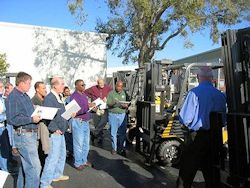Operator Training
Requirements
OSHA regulations require that the employer ensure that a forklift operator is competent to operate the forklift he or she is assigned to use. Training must be conducted by a competent person.

The employer must document operator training and an evaluation of the operator's performance while using the forklift.
Initial forklift training has three parts:
- Formal instruction may include a lecture, discussion, interactive computer learning, videotape and/or written material (can be taken anywhere).
- Practical training includes hands-on demonstration(s) by the trainer and exercises by the trainee (on the model of forklift the worker will use). Trainees may operate forklifts only under direction of a competent trainer, in a learning environment where doing so will not endanger the trainee or other employees. Be sure to set up a safe training area for practice.
- Evaluation of the effectiveness of the training by observing the operator's performance using the forklift should be conducted in the actual workplace. This evaluation must be repeated at least once every three years (must be at workplace each time).
Refresher training must be given if the operator has been involved in an accident, near miss or unsafe operations. Also, if an operator is assigned to a new type of forklift or if workplace conditions change that could affect safety, then refresher training is required.
Knowledge Check Choose the best answer for the question.
2-1. Which of the following lists the three components of forklift training?
You forgot to answer the question!
